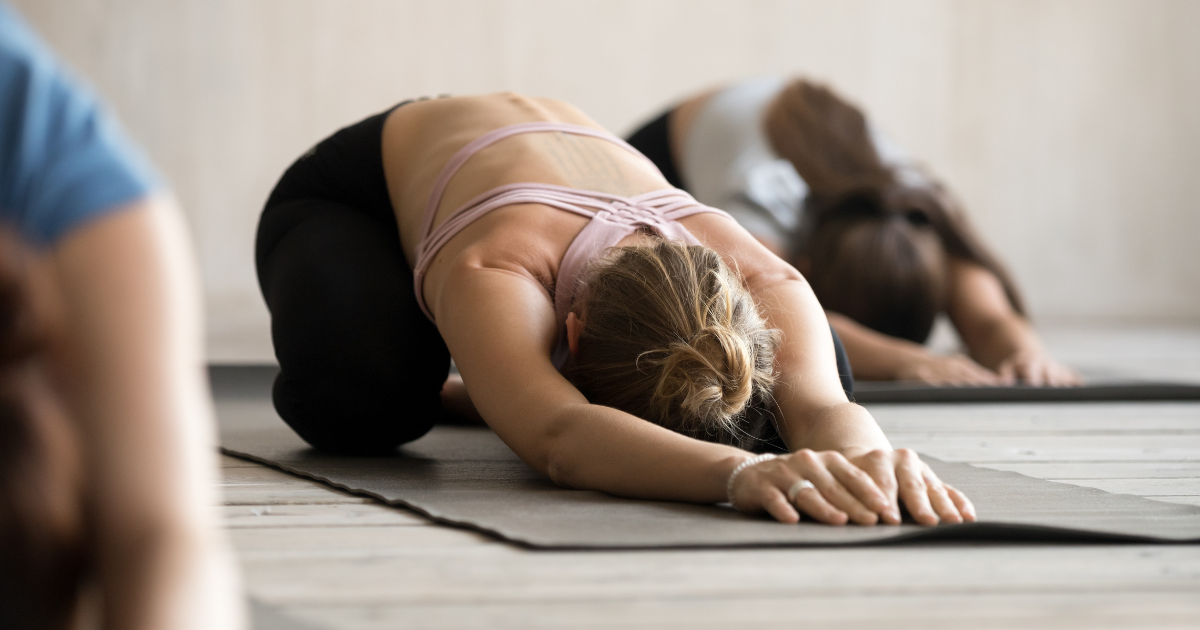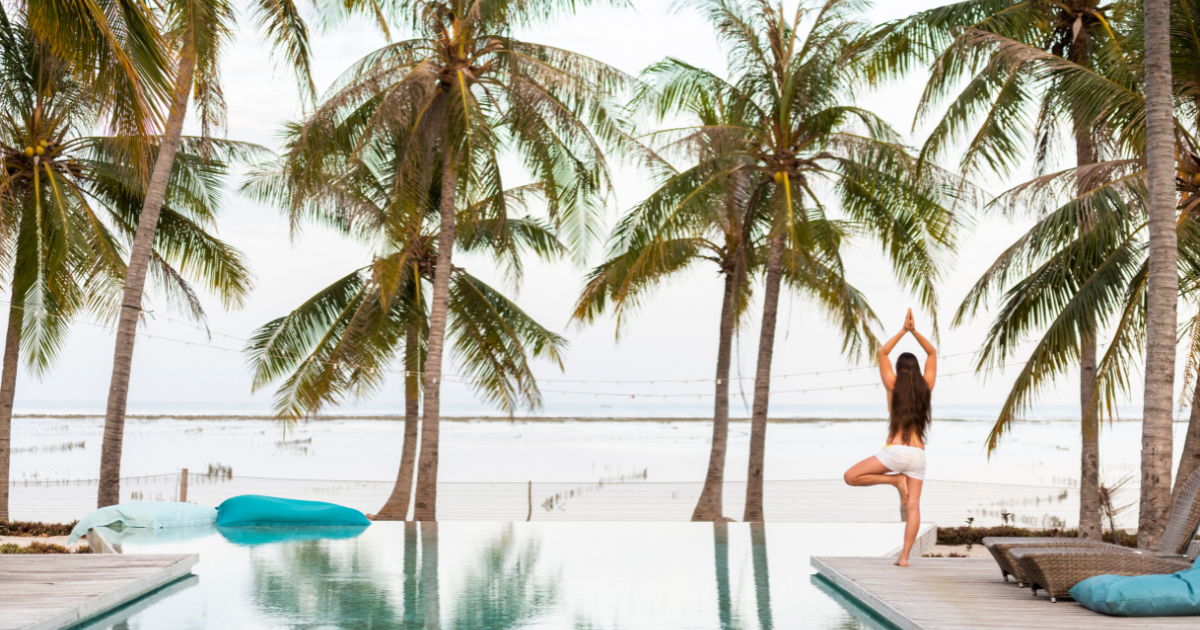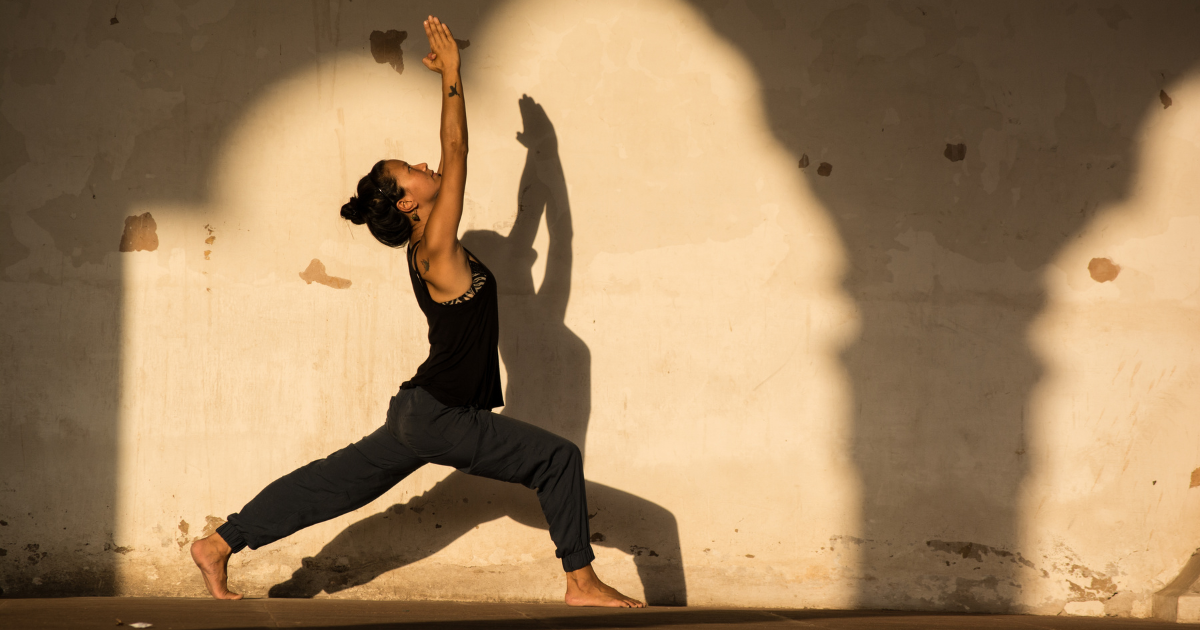Child's Pose (Balasana) is a foundational yoga pose that mirrors the natural fetal position. It's a resting pose that serves as a sanctuary of calm in the midst of yoga's dynamic flows. It beckons stillness, inviting you to turn inward and reconnect with yourself amidst life's chaos.
This pose is not just about physical rest; it's about emotional and mental rejuvenation, too. This guide covers all about Child's Pose—the step-by-step instructions, the benefits, and some popular Child's Pose variations and modifications.
Benefits of Child's Pose
As a resting pose, Child's Pose plays a critical role in transitioning smoothly between more intense yoga poses, giving your body a much-needed break. That said, it’s beginner friendly if you’re new to yoga.
It gently stretches your lower back, hips, thighs, knees, and ankles, promoting flexibility and relieving tension in areas prone to stiffness. Furthermore, by laying your forehead on the ground, you're encouraged to let go of all stress and enter a state of deep relaxation.
However, the benefits of Child's Pose extend beyond the physical. It's a pose that nurtures the soul, calming the mind and soothing the heart. This pose activates your parasympathetic nervous system, the part of your body responsible for rest and digestion. This shift not only relaxes your muscle tension but also lowers stress levels, improves sleep quality, and enhances overall emotional well-being.
Step-by-step instructions

- Begin in a Tabletop Pose, with your wrists under your shoulders and your knees under your hips. Keep your toes pointed straight back.
- Bring your big toes together and sit back on your heels. Your knees can be together or spread apart, depending on what feels more comfortable for you.
- As you exhale, slowly lower your torso down between your thighs.
- If your knees are together, your torso will rest on your thighs. If your knees are apart, your torso will sink between them.
- There are two common variations for your arms.
- Classic variation: Let your arms rest alongside your body, palms facing up. This can be more relaxing and grounding.
- Extended variation: Stretch your arms forward with your palms facing down, extending through your fingertips. This provides a gentle stretch for your shoulders and back.
- Allow your forehead to rest on the yoga mat. If it doesn't comfortably reach the mat, you can support it with a block or pillow.
- Close your eyes and take slow, deep breaths. Focus on inhaling deeply into your lower back and exhaling fully.
- Stay in Child's Pose for as long as it feels comfortable. This could be anywhere from a few breaths to several minutes. Use this time to relax and release any tension in your body.
- When you're ready to come out of the pose, slowly walk your hands back towards your body if they were extended.
- Use an inhale to gently lift your torso back up to a seated position on your heels.
Common mistakes
While Child's Pose may seem straightforward, common mistakes can hinder its benefits. One such mistake is not allowing enough space between the knees, which can create discomfort in the hips and lower back. It's essential to listen to your body and adjust your knee width to a comfortable and supportive position.
Another common oversight is holding tension in the shoulders and neck. Many practitioners unconsciously lift their shoulders towards their ears, creating strain rather than relaxation. Remember to consciously release any tension in these areas, allowing your shoulders to soften away from your ears and your neck to relax fully.
Additionally, some people rush into the pose without focusing on their breath, missing out on its calming effects. The essence of Child's Pose lies in deep, mindful breathing that promotes relaxation and stress release. Take your time to settle into the pose, using your breath as a guide to deepen your relaxation.
What and how to prepare
Preparing for Child's Pose begins with creating a comfortable and supportive environment on your yoga mat. Placing a folded blanket beneath your knees or ankles can provide extra cushioning and support. Similarly, if your forehead doesn't comfortably reach the ground, consider using a yoga block or a folded towel to bring the ground closer to you.
It's also helpful to wear comfortable, stretchy clothing that doesn't restrict your movement or breathing. Before entering Child's Pose, take a few deep breaths to center yourself and set an intention for your practice. This preparatory step enhances your physical comfort and prepares your mind for the peace and relaxation that Child's Pose offers.
Modifications and variations
Child's Pose can be modified to accommodate various needs and preferences, ensuring everyone can enjoy its benefits. Remember, the key to Child's Pose is comfort and relaxation, so feel free to experiment with these modifications until you find what feels best for you.
Wide Knee Child's Pose

Image source: Well+Good
Wide knees Child's Pose is a wonderful variation that offers additional benefits, especially for those with tight hips or lower back discomfort.
How-to: Spread your knees as wide as feels comfortable, ensuring your big toes still touch. As you fold forward, you'll notice an increased stretch in your hips and inner thighs.
This position also allows for more space for your belly or breasts, making it a comfortable option for everyone, including pregnant women seeking gentle exercise.
Child's Pose with bolster

A bolster can be your best friend for a more restorative version of Child's Pose.
How-to: Lay it lengthwise in front of you and gently drape your body over it, letting your stomach and chest be fully supported.
This variation allows for deeper relaxation and is particularly beneficial if the traditional pose is straining. The bolster supports your torso, enabling you to effectively release back, shoulders, and neck tension.
Thread the Needle Child's Pose

Image Source: AloMoves
Adding a twist to Child's Pose, 'Thread the Needle' incorporates a shoulder stretch into the mix.
How-to: From Child's Pose, slide one arm under your body with the palm facing up, resting your head on the yoga mat.
This variation targets your shoulders and arms, providing a gentle stretch while maintaining the pose's calming essence. Make sure you do both sides to maintain balance in your body. It's a wonderful way to add a subtle yet effective stretch to your practice, enhancing flexibility and relieving tension in the upper body.
Child's Pose with bind

Incorporating a bind into Child's Pose can deepen the stretch in your shoulders and chest.
How-to: Reach your hands behind your back, clasp them together, and gently lift your arms away from your body. Be mindful of your body's signals, and never push into pain.
This variation is particularly beneficial if you're looking to increase shoulder flexibility and release chest tightness. Let each exhale help you soften into the pose, deepening the bind only as far as your body comfortably allows.
Risks of Child's Pose
While Child's Pose is generally safe, being aware of potential risks is crucial, especially if you have knee or ankle issues. To protect your knees, ensure you don't force them too tightly together or put excessive pressure on them by leaning back too far. Placing a folded blanket under your knees or thighs can offer additional support and alleviate strain if you feel discomfort.
For those with ankle discomfort, a rolled towel under the ankles can reduce stress on these joints. Always listen to your body, adjusting the pose to avoid discomfort. If you have a pre-existing condition, consult a healthcare provider before adding Child's Pose to your routine. Remember, yoga is about finding balance and ease, not pushing through pain.
Frequently asked questions
What does Child's Pose do?
Child's Pose is a resting position in yoga that stretches your back, hips, and thighs while encouraging deep breaths that help to calm your nervous system. This pose is a great way to relieve stress and fatigue, making you feel refreshed and nurtured.
How long should you hold a child's pose?
Holding the Child's Pose for one to three minutes can be profoundly calming and restorative. It's long enough to allow your body to relax deeply into the stretch and your mind to find a moment of peace. Listen to your body and exit the pose if you feel any discomfort.
Who should not do Child's Pose?
Individuals with knee or ankle injuries should approach Child's Pose with caution or avoid it altogether. Pregnant women, especially in their third trimester, may find the traditional version uncomfortable and should modify it to meet their needs. Always consult with a healthcare provider if unsure.
Is Child's Pose bad for the knees?
For some, Child's Pose can put pressure on the knees. If you experience discomfort, try placing a yoga pad under your knees for extra cushioning. Alternatively, you can use modifications to reduce strain. It's crucial to listen to your body and adjust the pose to avoid pain.
Why is Child's Pose so calming?
Child's Pose taps into your body's natural relaxation response by encouraging deep breaths and offering a gentle stretch. This pose mimics a fetal position, which can instinctively evoke feelings of safety and comfort, helping to calm the mind and ease stress.
The bottom line
Child’s Pose, or Balasana, is a wonderful counterpose to many other yoga poses and helps passively stretch the muscles of the back, shoulders, and arms. Holding the pose for a couple of minutes can feel like a mini-retreat for your body and mind.
If you have a knee or hip issue, remember to move into the pose slowly and with caution. For those with a knee or shoulder injury, consider using modifications like a bolster or blocks for support.
Practicing Child's Pose can be a serene experience, offering a moment of calm in your yoga routine. Now you have it—it's time to give Child's Pose a try!





